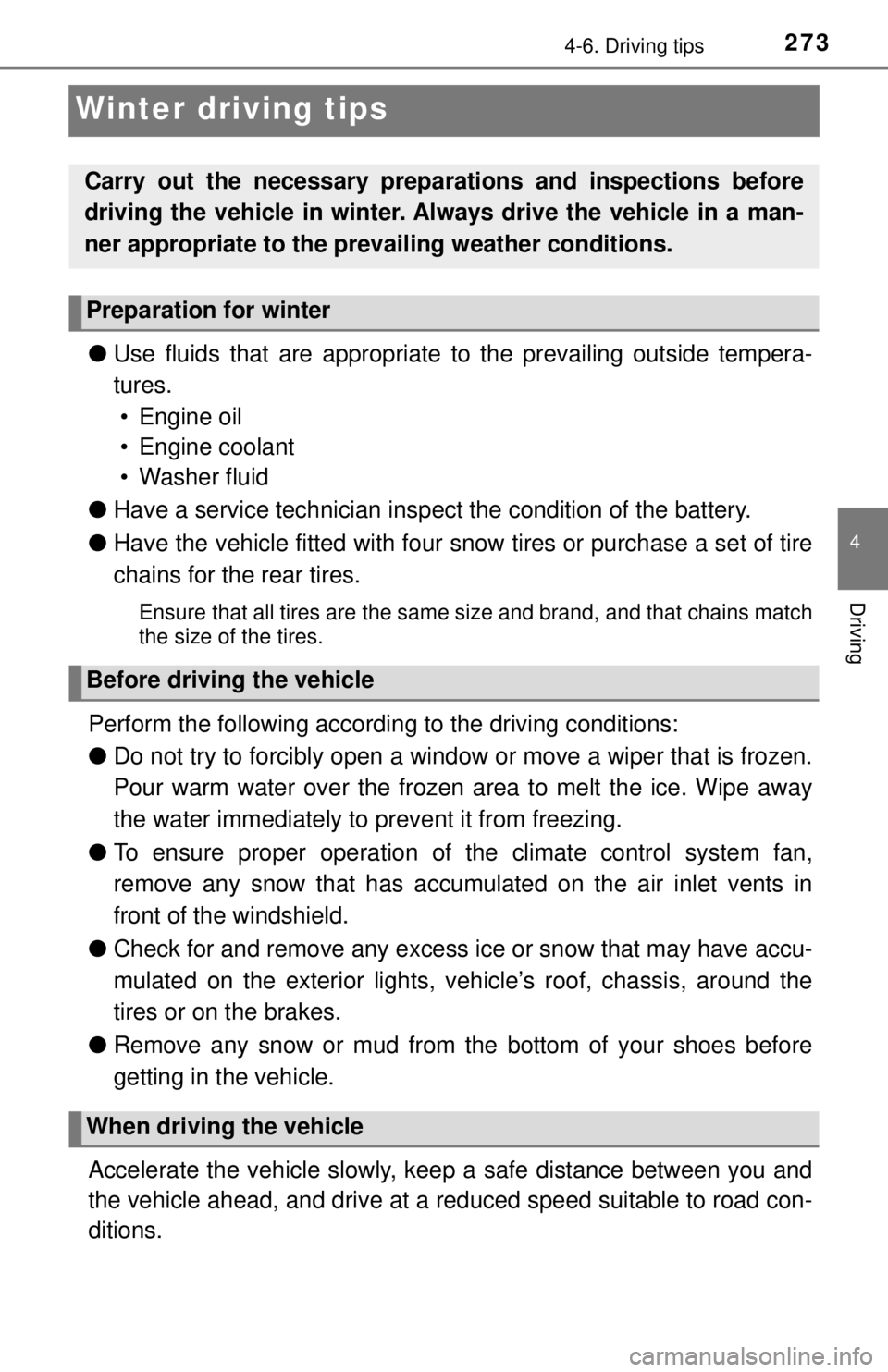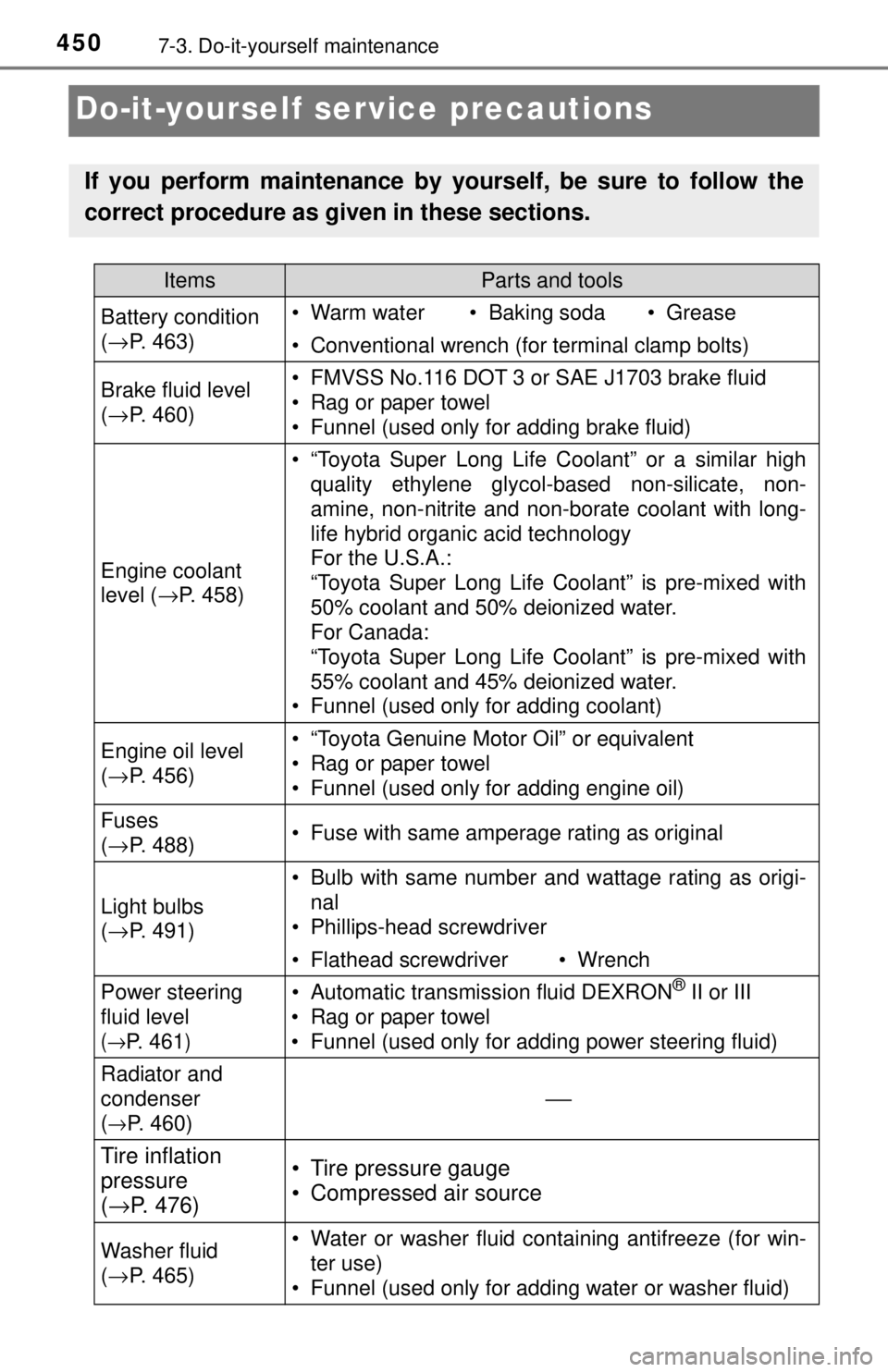Page 88 of 640
882. Instrument cluster
Gauges and meters
Vehicles without a multi-information display
Tachometer
Displays the engine speed in revolutions per minute
Shift position and shift range (vehicles with an automatic transmis-
sion)
Displays the selected shift position or selected shift range. ( →P. 197)
Outside temperature
Displays the outside temperature within the range of -40°F (-40°C) to
122°F (50°C). Outside temperature blinks 10 times when temperature is
below 37°F (3°C)
Speedometer
Displays the vehicle speed
Fuel gauge
Displays the quantity of fuel remaining in the tank
Odometer/trip meter
→P. 9 0
“ODO/TRIP” and instrument panel light control button
→P. 9 0
Engine coolant temperature gauge
Displays the engine coolant temperature
1
2
3
4
5
6
7
8
Page 89 of 640
892. Instrument cluster
2
Instrument cluster
Vehicles with a multi-information display
Tachometer
Displays the engine speed in revolutions per minute.
Outside temperature
Displays the outside temperature within the range of -40°F (-40°C) to
122°F (50°C). Low outside temperature indicator comes on when the
ambient temperature is 37°F (3°C) or lower.
Speedometer
Displays the vehicle speed.
Fuel gauge
Displays the quantity of fuel remaining in the tank.
Multi-information display
Presents the driver with a variety of vehicle data. ( →P. 9 4 )
Displays warning messages in case of a malfunction. ( →P. 523)
Odometer/trip meter
→P. 9 0
Shift position and shift range (vehicles with an automatic transmis-
sion)
Displays the selected shift position or selected shift range. ( →P. 197)
“ODO/TRIP” and instrument panel light control button
→P. 9 0
Engine coolant temperature gauge
Displays the engine coolant temperature.
1
2
3
4
5
6
7
8
9
Page 92 of 640
922. Instrument cluster
WARNING
■The information display at low temperatures
Allow the interior of the vehicle to warm up before using the liquid crystal
information display. At extremely low temperatures, the information display
monitor may respond slowly, and display changes may be delayed.
For example, there is a lag between the driver’s shifting and the new gear
number appearing on the display. This lag could cause the driver to down-
shift again, causing rapid and excessive engine braking and possibly an
accident resulting in personal death or injury.
NOTICE
■To prevent damage to the engine and its components
● Do not let the indicator needle of the tachometer enter the red zone, which
indicates the maximum engine speed.
● The engine may be overheating if the engine coolant temperature gauge is
in the red zone (H). In this case, immediately stop the vehicle in a safe
place, and check the engine after it has cooled completely. (→ P. 563)
Page 182 of 640

1824-1. Before driving
●Slow down before making a turn, in crosswinds, on wet or slippery
surfaces, etc.
Increasing vehicle speed c an destabilize the trailer.
● Take care when passing other vehicles. Passing requires consider-
able distance. After passing a vehi cle, do not forget the length of
your trailer, and be sure you hav e plenty of room before changing
lanes.
● Vehicles with an automatic transm ission: To maintain engine brak-
ing efficiency and charging syst em performance when using engine
braking, do not use the transmiss ion in D. If in the S mode, the
transmission shift range position must be in 5 or lower.
● Vehicles with a manual transmission: To maintain engine braking
efficiency and charging system performance when using engine
braking, do not use t he fifth gear (5-speed manual transmission) or
the sixth gear (6-speed manual transmission).
● Instability happens more frequently when descending steep or long
downhill grades. Before descending, slow down and downshift. Do
not make sudden downshifts while descending steep or long down-
hill grades.
● Avoid holding the brake pedal down too long or applying the brakes
too frequently. This could cause the brakes to overheat and result in
reduced braking efficiency.
● Due to the added load of the trailer, your vehicle’s engine may over-
heat on hot days (at temperatures over 85°F [30°C]) when driving
up a long or steep grade. If t he engine coolant temperature gauge
indicates overheating, immediately turn off the air conditioning (if in
use), pull your vehicle off the road and stop in a safe spot.
( → P. 563)
Page 273 of 640

2734-6. Driving tips
4
Driving
Winter driving tips
●Use fluids that are appropriate to the prevailing outside tempera-
tures. • Engine oil
• Engine coolant
• Washer fluid
● Have a service technician ins pect the condition of the battery.
● Have the vehicle fitted with four snow tires or purchase a set of tire
chains for the rear tires.
Ensure that all tires are the same size and brand, and that chains match
the size of the tires.
Perform the following accordin g to the driving conditions:
● Do not try to forcibly open a window or move a wiper that is frozen.
Pour warm water over the frozen area to melt the ice. Wipe away
the water immediately to prevent it from freezing.
● To ensure proper operation of the climate control system fan,
remove any snow that has accumulated on the air inlet vents in
front of the windshield.
● Check for and remove any excess ice or snow that may have accu-
mulated on the exterior lights, vehicle’s roof, chassis, around the
tires or on the brakes.
● Remove any snow or mud from the bottom of your shoes before
getting in the vehicle.
Accelerate the vehicle slowly, keep a safe distance between you and
the vehicle ahead, and drive at a reduced speed suitable to road con-
ditions.
Carry out the necessary preparations and inspections before
driving the vehicle in winter. Al ways drive the vehicle in a man-
ner appropriate to the prevailing weather conditions.
Preparation for winter
Before driving the vehicle
When driving the vehicle
Page 446 of 640
4467-2. Maintenance
General maintenance
Listed below are the general maintenance items that should be
performed at the intervals specified in the “Owner’s Warranty
Information Booklet” or “Owner’s Manual Supplement/Sched-
uled Maintenance Guide”. It is recommended that any problem
you notice should be brought to the attention of your Toyota
dealer or qualified service shop for advice.
Engine compartment
ItemsCheck points
BatteryCheck the connections. (→P. 463)
Brake fluidIs the brake fluid at the correct level? ( →P. 460)
Engine coolantIs the engine coolant at the correct level? (→P. 458)
Engine oilIs the engine oil at the correct level? (→P. 456)
Exhaust systemThere should not be any fumes or strange sounds.
Power steering fluidIs the power steering fluid at correct level?
(→P. 461)
Radiator/condenserThe radiator and condenser should be free from for-
eign objects. ( →P. 460)
Washer fluidIs there sufficient washer fluid? (→P. 465)
Page 450 of 640

4507-3. Do-it-yourself maintenance
Do-it-yourself service precautions
If you perform maintenance by yourself, be sure to follow the
correct procedure as given in these sections.
ItemsParts and tools
Battery condition
(→ P. 463)• Warm water• Baking soda• Grease
• Conventional wrench (for terminal clamp bolts)
Brake fluid level
(→ P. 460)• FMVSS No.116 DOT 3 or SAE J1703 brake fluid
• Rag or paper towel
• Funnel (used only for adding brake fluid)
Engine coolant
level ( →P. 458)
• “Toyota Super Long Life Coolant” or a similar high
quality ethylene glycol-based non-silicate, non-
amine, non-nitrite and non-borate coolant with long-
life hybrid organic acid technology
For the U.S.A.:
“Toyota Super Long Life Coolant” is pre-mixed with
50% coolant and 50% deionized water.
For Canada:
“Toyota Super Long Life Coolant” is pre-mixed with
55% coolant and 45% deionized water.
• Funnel (used only for adding coolant)
Engine oil level
( → P. 456)• “Toyota Genuine Motor Oil” or equivalent
• Rag or paper towel
• Funnel (used only for adding engine oil)
Fuses
(→ P. 488)• Fuse with same amperage rating as original
Light bulbs
(→ P. 491)
• Bulb with same number and wattage rating as origi-
nal
• Phillips-head screwdriver
• Flathead screwdriver• Wrench
Power steering
fluid level
(
→P. 461)
• Automatic transmission fluid DEXRON® II or III
• Rag or paper towel
• Funnel (used only for adding power steering fluid)
Radiator and
condenser
(
→P. 460)
⎯
Tire inflation
pressure
( → P. 476)• Tire pressure gauge
• Compressed air source
Washer fluid
(→ P. 465)• Water or washer fluid containing antifreeze (for win-
ter use)
• Funnel (used only for adding water or washer fluid)
Page 454 of 640
4547-3. Do-it-yourself maintenance
Engine compartment
2TR-FE engine
Washer fluid tank (→P. 465)
Radiator cap
Engine coolant reservoir (→ P. 458)
Engine oil filler cap ( →P. 457)
Power steering fluid reservoir (→ P. 461) Engine oil level dipstick
(→ P. 456)
Brake fluid reservoir (→ P. 460)
Fuse box ( →P. 488)
Battery (→ P. 463)
Condenser ( →P. 460)
Radiator ( →P. 460)1
2
3
4
5
6
7
8
9
10
11